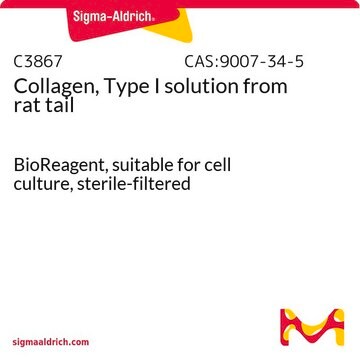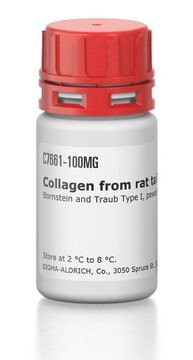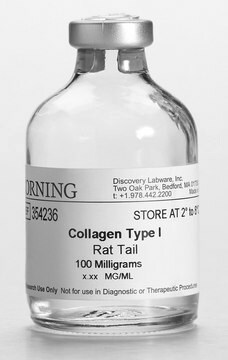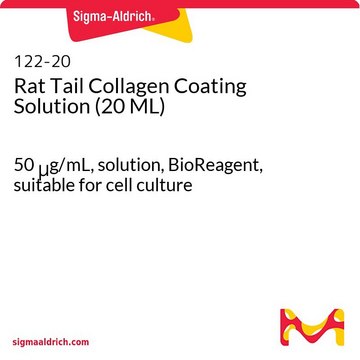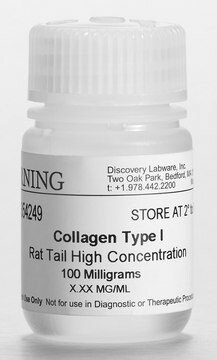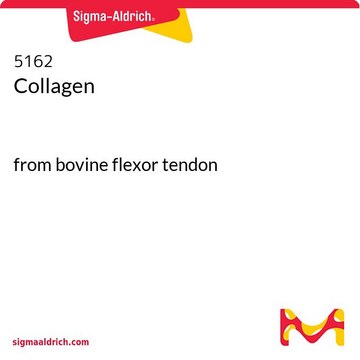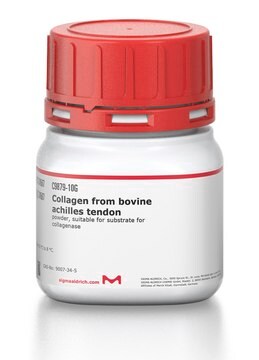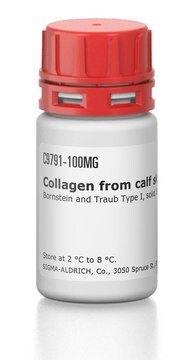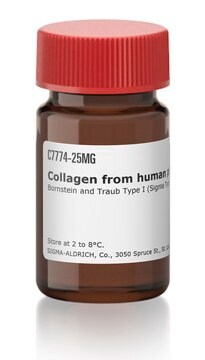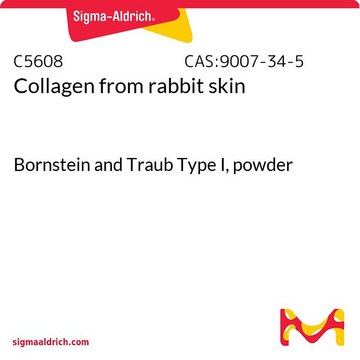11179179001
Roche
Collagen
from rat tail tendon
Sinonimo/i:
collagen
About This Item
Prodotti consigliati
Origine biologica
rat tail
Livello qualitativo
Sterilità
sterile
Stato
lyophilized (clear, colorless solution after reconstitution)
Confezionamento
pkg of 30 mg
Produttore/marchio commerciale
Roche
tecniche
cell culture | mammalian: suitable
N° accesso UniProt
Temperatura di conservazione
2-8°C
Informazioni sul gene
rat ... Col1a1(29393)
Descrizione generale
Specificità
Applicazioni
Azioni biochim/fisiol
Caratteristiche e vantaggi
Lyophilizate, cell culture grade, 3 vials of 10mg
Specifiche
Nota sulla preparazione
5 μg/cm2 for the coating of cell culture vessels; for the preparation of collagen gels, a final concentration of 2 to 3 mg/ml is used.
Ricostituzione
For the preparation of collagen gels, the content of the bottle should be dissolved in 3.3 ml sterile 0.2% acetic acid (v/v) each. This results in a final concentration of 3 mg/ml.
For coating culture dishes the final concentration should be 1 to 2 mg/ml.
Note: For dissolving: do not stir, just pour the acetic acid onto the lyophilizate and allow it to stand for several hours until it has dissolved. To completely dissolve the product an incubation for up to a maximum of 24 hours at 15 to 25 °C may be required.
Reconstitution of the Collagen should be done at 15 to 25 °C, higher temperatures destroy the fibres and may prevent the subsequent gelation of the Collagen.
Altre note
Codice della classe di stoccaggio
11 - Combustible Solids
Classe di pericolosità dell'acqua (WGK)
WGK 1
Punto d’infiammabilità (°F)
does not flash
Punto d’infiammabilità (°C)
does not flash
Scegli una delle versioni più recenti:
Possiedi già questo prodotto?
I documenti relativi ai prodotti acquistati recentemente sono disponibili nell’Archivio dei documenti.
I clienti hanno visto anche
Articoli
The extracellular matrix (ECM) is secreted by cells and surrounds them in tissues.
3D cell culture overview. Learn about 2D vs 3D cell culture, advantages of 3D cell culture, and techniques available to develop 3D cell models
Extracellular matrix proteins such as laminin, collagen, and fibronectin can be used as cell attachment substrates in cell culture.
Il team dei nostri ricercatori vanta grande esperienza in tutte le aree della ricerca quali Life Science, scienza dei materiali, sintesi chimica, cromatografia, discipline analitiche, ecc..
Contatta l'Assistenza Tecnica.